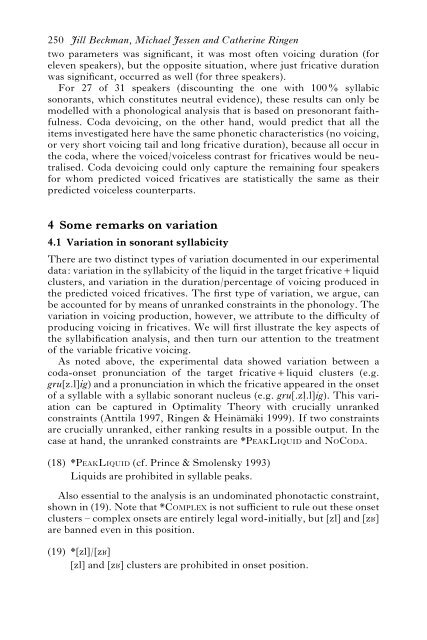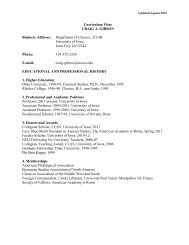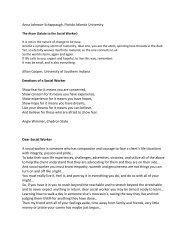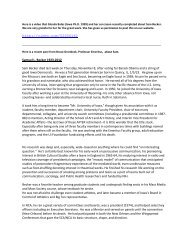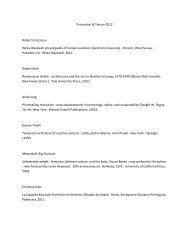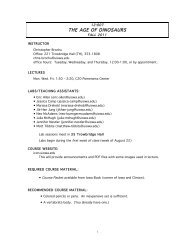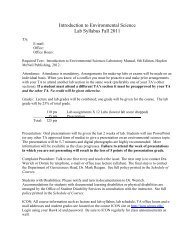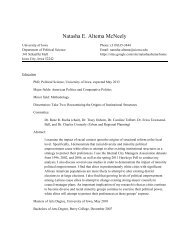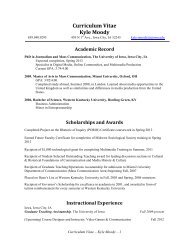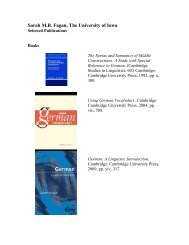German fricatives: coda devoicing or positional faithfulness?
German fricatives: coda devoicing or positional faithfulness?
German fricatives: coda devoicing or positional faithfulness?
Create successful ePaper yourself
Turn your PDF publications into a flip-book with our unique Google optimized e-Paper software.
250 Jill Beckman, Michael Jessen and Catherine Ringen<br />
two parameters was significant, it was most often voicing duration (f<strong>or</strong><br />
eleven speakers), but the opposite situation, where just fricative duration<br />
was significant, occurred as well (f<strong>or</strong> three speakers).<br />
F<strong>or</strong> 27 of 31 speakers (discounting the one with 100% syllabic<br />
son<strong>or</strong>ants, which constitutes neutral evidence), these results can only be<br />
modelled with a phonological analysis that is based on preson<strong>or</strong>ant <strong>faithfulness</strong>.<br />
Coda <strong>devoicing</strong>, on the other hand, would predict that all the<br />
items investigated here have the same phonetic characteristics (no voicing,<br />
<strong>or</strong> very sh<strong>or</strong>t voicing tail and long fricative duration), because all occur in<br />
the <strong>coda</strong>, where the voiced/voiceless contrast f<strong>or</strong> <strong>fricatives</strong> would be neutralised.<br />
Coda <strong>devoicing</strong> could only capture the remaining four speakers<br />
f<strong>or</strong> whom predicted voiced <strong>fricatives</strong> are statistically the same as their<br />
predicted voiceless counterparts.<br />
4 Some remarks on variation<br />
4.1 Variation in son<strong>or</strong>ant syllabicity<br />
There are two distinct types of variation documented in our experimental<br />
data: variation in the syllabicity of the liquid in the target fricative+liquid<br />
clusters, and variation in the duration/percentage of voicing produced in<br />
the predicted voiced <strong>fricatives</strong>. The first type of variation, we argue, can<br />
be accounted f<strong>or</strong> by means of unranked constraints in the phonology. The<br />
variation in voicing production, however, we attribute to the difficulty of<br />
producing voicing in <strong>fricatives</strong>. We will first illustrate the key aspects of<br />
the syllabification analysis, and then turn our attention to the treatment<br />
of the variable fricative voicing.<br />
As noted above, the experimental data showed variation between a<br />
<strong>coda</strong>-onset pronunciation of the target fricative+liquid clusters (e.g.<br />
gru[z.l]ig) and a pronunciation in which the fricative appeared in the onset<br />
of a syllable with a syllabic son<strong>or</strong>ant nucleus (e.g. gru[.z&.l]ig). This variation<br />
can be captured in Optimality The<strong>or</strong>y with crucially unranked<br />
constraints (Anttila 1997, Ringen & Heinämäki 1999). If two constraints<br />
are crucially unranked, either ranking results in a possible output. In the<br />
case at hand, the unranked constraints are *PEAKLIQUID and NOCODA.<br />
(18)<br />
*PeakLiquid (cf. Prince & Smolensky 1993)<br />
Liquids are prohibited in syllable peaks.<br />
Also essential to the analysis is an undominated phonotactic constraint,<br />
shown in (19). Note that *COMPLEX is not sufficient to rule out these onset<br />
clusters – complex onsets are entirely legal w<strong>or</strong>d-initially, but [zl] and [zH]<br />
are banned even in this position.<br />
(19)<br />
*[zl]/[z]<br />
[zl] and [z] clusters are prohibited in onset position.


